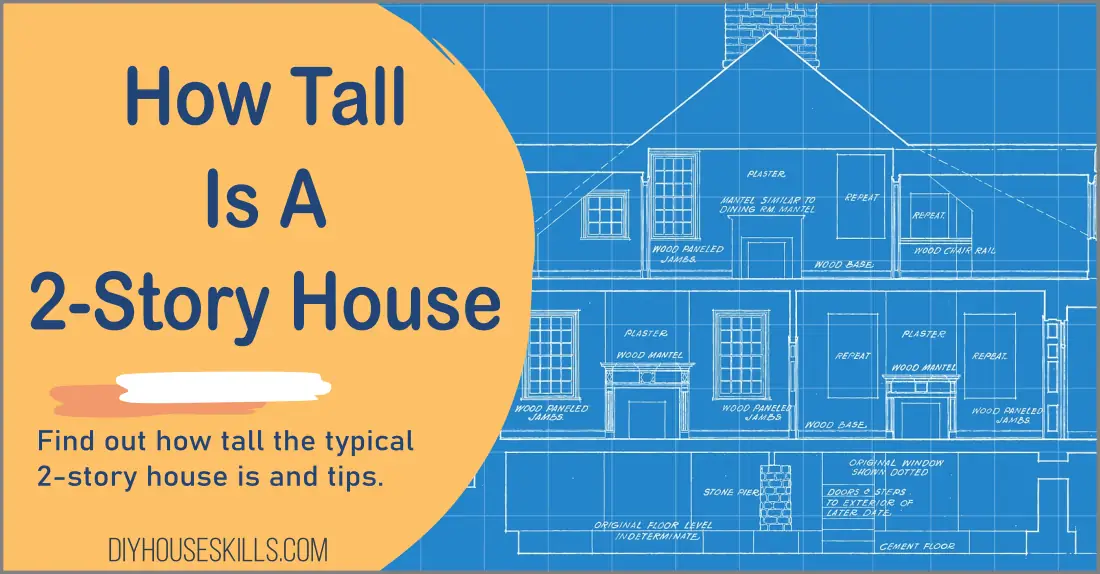- How tall is a 2-story house? How does the height of a two-story house compare to the average height of a one-story house?
- How does the height of a two-story house compare to the average height of a three-story house?
- These are all valid questions that can be answered by looking at the floor-to-ceiling height of a two-story house.
- See even more Maintenance and Information Guide articles.
How tall is a 2 story house? This is a question that doesn’t have a straightforward answer as the height of a two-story house can vary quite significantly.
In this blog post, we will take a look at how height can vary and what factors play into it. We will also discuss how to measure the height of a two-story house.
So, if you’re curious about how tall a 2-story house is, keep reading.
How Tall Is A 2-Story House?
How tall is a 2-story house? On average the height of a two-story house including both floors and the roof is about 26 feet.
However, this can vary depending on the type of house and the specific design.
For example, some two-story houses have a flat roof, which can impact the total height of the building.

Additionally, building codes in the United States typically require a minimum height for residential and commercial buildings.
Finally, it is important to note that ceiling heights can vary from floor to floor in a two-story house.
For example, the first floor may have a ceiling height of 9 feet, while the second floor may have a ceiling height of 8 feet.
Building Trends:
It is more common today to find homes with 9 or even 10-foot ceilings on the first floor. While 8-foot used to be standard in older homes, the trend has been to increase the room height.
This is done for a variety of reasons, including the feeling of more space and the ability to add taller windows.
As a result, the average height of a two-story house has increased in recent years.
ALSO READ: Easy Newbie Home Maintenance
How Tall Is A Story?
A story is defined as the height of one level in a building.
Story height is largely determined by the building material used. Skydeck.com lists the following:
- Wood wall framing – Max story height of 11 feet, 7 inches.
- Cold-formed steel wall framing – Max story height of 11 feet, 7 inches.
- Masonry walls – Max story height of 13 feet, 7 inches.
- Insulated concrete form walls – Max story height of 11 feet, 7 inches; max unsupported wall height per story of 10 feet.
- Structural insulated panel walls – Max story height of 11 feet, 7 inches; bearing wall height per story of 10 feet.
1-Story House:
The average floor-to-ceiling height for a one-story house is about eight to nine feet. The height of a story is measured from the floor to the ceiling.
This is the interior living space of the house and does not include the thickness of the slab or the ceiling rafters.
1-Story Building:
The height of a one-story building is about 14 feet which includes the floor thickness. This of course varies by building material used.
How Tall is a Story in Feet?
The average interior roof height of a 1 story house is about 9 feet, so when you add a standard roof height, the average height of a one-story house including the roof is about 16 feet.
How Tall is a Storey in Meters?
In meters, the average is 3 to 4.5 m.
ALSO READ: Best Garage Storage System In 2022: Organize Your Space
How Tall Is A 3 Story House?
A three-story house is typically about 36 feet high. This is determined by the height of all three floors, the attic height, and the building materials such as floor joists and attic rafters.
Three-story houses are rare and are mostly found in urban areas where land is scarce.
How Tall Is A Typical House?
A typical house in the U.S. is about 16 feet tall, which is for a single-story house including the roof.
ALSO READ: How To Conserve Water At Home
What Determines The Height Of A House?
There are a few factors that play into the height of a house.
- First, the type of house will impact the height. For example, a one-story ranch-style house is going to be shorter than a two-story colonial.
- Second, the building materials used will also play a role in how tall the house is. As we mentioned before, masonry walls are going to be taller than wood walls.
- Finally, the height of the house may be impacted by the local building codes. These codes will typically dictate how tall a residential or commercial building can be.
The height of a house can vary quite significantly. It is important to take into account the type of house, the building materials used, and the local building codes when determining how tall a house is.
Frequently Asked Questions:
There is no definitive answer to this question. It depends on several factors, including the type of house, the building materials used, and the local building codes.
The answer depends on several factors such as where you live, the building codes, and the materials you are using to build with.
I hope this article helped answer the question, “How tall is a two-story house?”
As you can see, many factors play into how tall a two-story house is.
It is important to consider all of these factors when designing or measuring the height of a two-story house.

I’m J.S., I created and am the content manager at DIYHouseSkills.com. I do the research and write the articles that appear on this website. I’ve learned many household skills during my life and think it’s important to at least know the basics so that you can save yourself time and money… READ FULL BIO >
- Samsung Robot Vacuum Troubleshooting + AdviceSamsung robot vacuum troubleshooting is for anyone experiencing issues with their POWERbot vacuum. Answers to your Samsung robot vacuum problems are covered in my article as I discuss the most common issues users have. Troubleshooting Samsung POWERbot Vacuums Robot vacuum problems can be a real headache. These intelligent devices make life easier when operating as expected. However, when issues arise it can be difficult to find… Read more: Samsung Robot Vacuum Troubleshooting + Advice
- Coffee Maker Cleaning for a Tastier Daily BrewDespite their importance in our morning routines, coffee makers are often overlooked when it comes to regular cleaning. However, neglecting to clean your coffee maker can have a significant impact on the quality and healthiness of your daily brew. In this post, we will explore the reasons why regular cleaning of your coffee maker is crucial. We will provide a simple and effective cleaning method, along… Read more: Coffee Maker Cleaning for a Tastier Daily Brew
- Easy Dishwasher Cleaning: How to Remove Odors, BacteriaThe best guide for easy dishwasher cleaning Your dishwasher is one of the most important appliances in your home. Not only does it make clean-up a breeze, but it also helps to keep your dishes clean and bacteria-free. However, if you don’t clean it on a regular basis, it can become a cesspool of bacteria, fungus, and odors. In this blog post, we will discuss how… Read more: Easy Dishwasher Cleaning: How to Remove Odors, Bacteria
- Garbage Disposal Not Working | You Can Fix ItIn this post I’ll talk about why your garbage disposal is not working and the steps to take so you can fix it yourself. Follow a few steps and you’ll have your garbage disposal working again in no time. After a while, most homeowners find themselves with garbage disposal problems. The disposal either stops working completely or starts making a humming sound. No need to call… Read more: Garbage Disposal Not Working | You Can Fix It
- Vacuum Cleaner Loss Of Suction | 5 Causes and SolutionsThis post is all about what causes a vacuum cleaner to lose suction and the top 5 causes with the solutions, so you can get your old vacuum working like new again. Over time vacuum cleaners can and do lose suction, which means it’s not picking up as much dirt and dust as they used to. While you could go out and buy a new vacuum… Read more: Vacuum Cleaner Loss Of Suction | 5 Causes and Solutions





